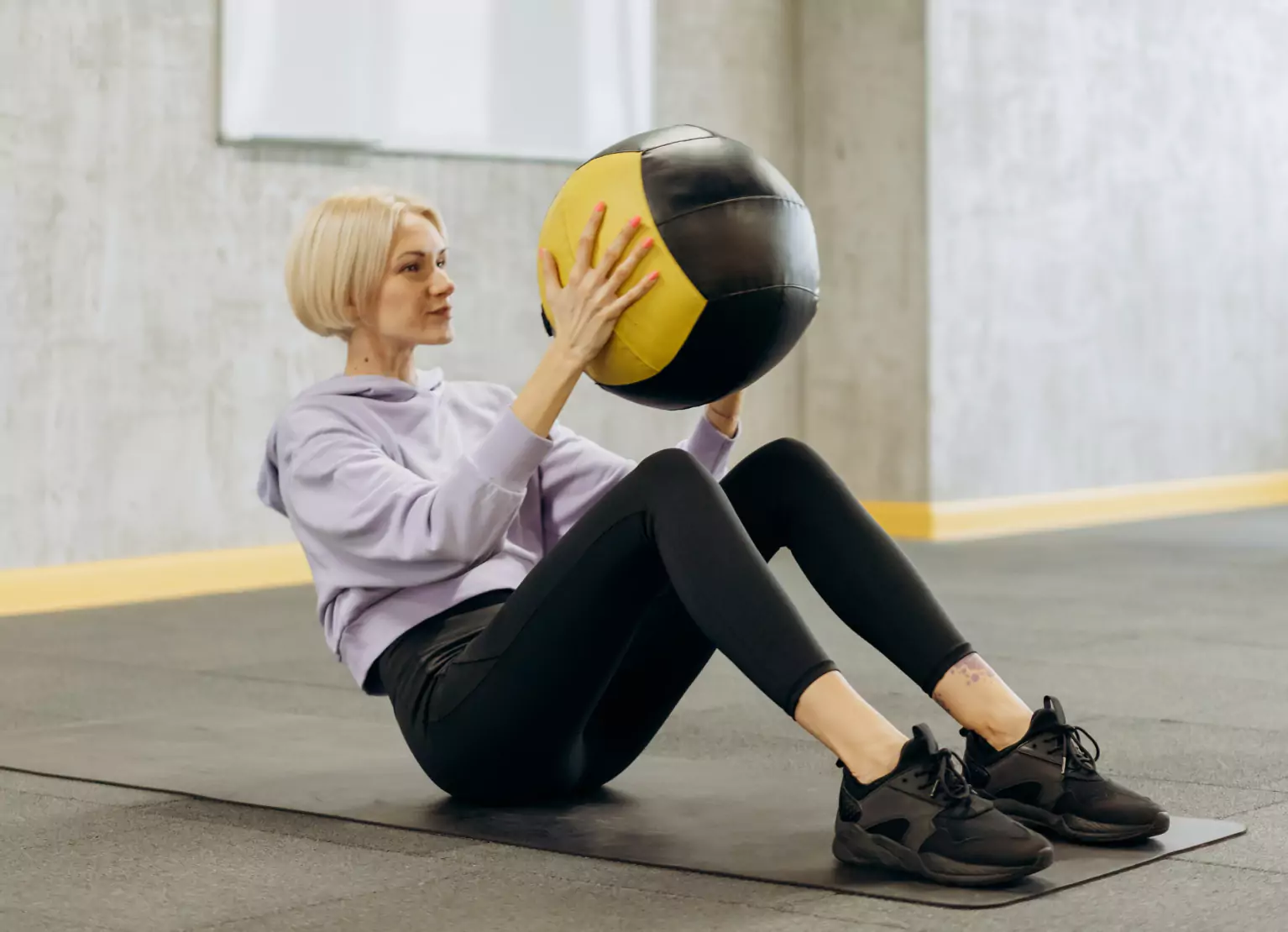What is High-Intensity Resistance Training [+ 9 Tips for Beginners]

Key Takeways
You may already be familiar with high-intensity interval training (or HIIT), which is a popular workout format focused around short periods of intense cardio exercise with little rest. However, not as many people have heard of HIRT (or high-intensity resistance training), which is a variation of HIIT training that can take your strength training to the next level.
While there are many similarities between HIIT and HIRT, there are also some key differences. If you’re looking for a new way to build strength, burn calories, and add some intensity to your workout routine, HIRT workouts may be a great option to explore.
Let‘s dive into what exactly HIRT is, how it differs from HIIT, and explore a few helpful tips beginners can use to take advantage of this metabolism-boosting workout.
What is HIRT?

HIRT is a variation of high-intensity interval training that primarily focuses on building muscle through a series or circuit of interval reps. The goal of this training is to keep your heart rate high while performing short strength movements with little rest in between.
HIRT can be done using your own bodyweight, but more advanced athletes may use dumbbells, free weights, or resistance bands. This type of training has been shown to increase resting energy expenditure, which may support fat loss, and is thought to put less stress on the body than HIIT exercises, which may have negative health effects if done in excess.
Like traditional resistance training, HIRT workouts typically target specific muscle groups, and may include exercises like deadlifts, bicep curls, and shoulder presses. HIRT workouts may take less time than traditional weight lifting routines, and can even be as short as 30 minutes long.
The Differences Between HIIT and HIRT Workouts
Both HIIT and HIRT workouts are made up of short bursts of high-intensity exercises with minimal rest in between each movement. Each type of routine usually consists of 1-3 circuits with longer breaks in between each circuit.
While HIIT tends to incorporate many different types of cardio-based exercises such as sprints and burpees, HIRT is solely focused on resistance training and generally requires equipment such as free weights or bands to complete (with the exception of beginners just starting with HIRT training).
Both HIIT and HIRT workouts can be beneficial for reducing body fat, but HIRT training was observed to have a greater impact on aerobic fitness on a sample of overweight individuals. Because HIRT workouts focus on building strength, the exercises tend to be slower and less demanding, and have even been observed to improve lung function in elderly individuals.
Benefits of High Intensity Resistance Training

There are many benefits of high intensity resistance training. Here are a few of the most important ones:
- Helps to increase muscle mass. Building muscles can increase your resting metabolic rate and accelerate weight loss, as muscles burn more calories at rest than fat.
- Helps to balance blood glucose levels.
- Increases overall aerobic fitness.
- Increases fat oxidation. While this study specifically looked at HIIT, the benefit can likely be applied to variations of HIIT workouts such as HIRT.
- Supports increased cardiovascular endurance.
9 Tips for Beginners Ready to Try HIRT
While HIRT can seem intimidating, it’s a great exercise that has a host of benefits to boost your overall health. So If you’re new to this variation of strength training, here are our top tips to get started.
1) Start Slow and Work Your Way Up
Following a HIRT routine will likely leave you with post-workout DOMS, also known as muscle fever or extreme muscle soreness, so it’s important to start slow if you‘re new to any kind of high-intensity exercise or if you haven‘t been active in awhile.
You may want to start slow with a shorter workout (perhaps 15 minutes) and gradually work up to a full workout. While you train, stick to the lower end of any time range you are given for the high intensity movement (around 10-15 seconds) and choose a rest period that will let you catch your breath.
Keep in mind that high-intensity workouts should be difficult to talk through, and as you become more experienced, you can gradually increase your workout length.
2) Modify Wherever You Can
Another tip for getting started with HIRT is to modify the exercises to fit your fitness level.
For example, if the workout requires you to do push-ups, but you’re not there yet, that’s okay. Instead, try a knee push-up.
You can also make use of a resistance band here by placing the band around your body, including the outside of both your arms. When doing banded push-ups, the resistance band will help support your chest as you come up and make the exercise easier to complete.
You can also apply this strategy to other exercises until your fitness level increases. If you’re doing a HIRT workout in a class, your instructor or personal trainer will share any modifications with you.
3) Use Your Bodyweight First
If you’ve never lifted weights before or are very new to resistance training, opting for bodyweight movements (instead of using dumbbells or kettlebells) can help you perfect your form and avoid getting overly sore.
Using your bodyweight when starting out with things like squats and lunges can still add considerable resistance to the workout. Once you feel more confident, you can start slowly adding in weighted exercises like bicep curls, deadlifts, and bench presses.
You can even start adding weights to your lunges and squats to challenge yourself further when you feel ready.
4) Make Sure to Stay Hydrated

Hydration is always important, but during a high intensity workout where you’re losing a lot of water, it‘s essential!
Hydration doesn‘t just mean drinking plenty of water, but also making sure your electrolytes (such as sodium, potassium, magnesium, calcium) are balanced. Research suggests that one session of exercise can lead to as much as 20-90 mmol of sodium loss through sweat.
Try adding a pinch of salt to the water you sip on during your workout or try drinking a low sugar electrolyte drink (LMNT or Nuun are two great options) with minerals like magnesium and potassium.
5) Blast Some Music During High-Intensity Training
Music has been shown to increase workout duration in a study conducted on a group of young adults, so it can be a great option if you need a motivational boost.
Try listening to some upbeat, fast-tempo music during your workouts or make a playlist of your favorite fast-paced songs to keep you in the zone.
This type of music can have some benefits on performance during endurance and high-intensity workouts, and it also makes working out more enjoyable. Don’t forget your headphones!
6) Change Up Your Workout Location
Doing your training workouts in the same location can start to get boring and may feel repetitive over time. That’s why switching up your workout location can make a world of a difference. If you usually workout at your neighborhood gym, try popping into another local branch.
Exercising in nature has been found to reduce your perceived level of exertion during workout in addition to other health benefits, so if the weather’s nice outside you may even consider taking your workout to a park.
Make a list of 3-5 different spots or places that would be fun to try out as your next workout spot to keep things interesting.
7) Vary Your Exercises
Along with switching up your location, it may be helpful to switch up your exercises every month or two to focus on other muscle groups and avoid getting stuck in a rut.
For example, if you’ve been doing lots of static weightlifting exercises, switch it up by incorporating plyometric movements like jump squats during your next month of training. You can also increase your weights if you’ve noticed your current ones no longer get your muscles to near failure.
8) Eat Plenty of Protein

Along with staying hydrated, getting enough protein is essential to the muscle growth process, especially before or after your workout.
When you lift weights, you are creating micro tears in your muscles that the body will then rebuild. This is how muscle growth, or hypertrophy, occurs over time.
However, in order for this process to be completed successfully, your body needs all nine essential amino acids that come from getting adequate protein in your diet.
You’ll want to consume complete, whole foods sources of protein such as:
- Eggs
- Poultry (pasture-raised when possible)
- Grass-fed beef
- Organ meats
- Tofu
- Tempeh
- Fish
Check out our article on the best recovery breakfasts for more muscle building meal ideas.
9) Do a Magnesium Salt Bath For Sore Muscles
There are a variety of methods for combating muscle soreness, such as dry needling, massage, and cryotherapy.
If you‘ve exhausted these options, another effective and relaxing option is to take a magnesium salt bath (also called epsom salt baths). Studies to support the efficacy of magnesium salt baths are mainly anecdotal, but some research suggests that epsom salt baths decrease perceived muscle pain or soreness.
Try it out if you‘re feeling sore and see if a magnesium salt bath works for you!
Find the right Nutrisense programto turn insight into progress.
Go Beyond Glucose Data with Nutrisense
Your glucose can significantly impact how your body feels and functions. That’s why stable levels are an important factor in supporting overall wellbeing. But viewing glucose isn't enough. Nutrisense, you’ll be able to learn how to use your body's data to make informed lifestyle choices that support healthy living.
One-to-one coaching
Sign up to access insurance-covered video calls to work with a glucose expert: a personal registered dietitian or certified nutritionist who will help tailor your lifestyle and diet to your goals.
Monitor and measure what matters
With the Nutrisense CGM Program, you can monitor your glucose with health tech like glucose biosensors and continuous glucose monitor (CGM)s, and analyze the trends over time with the Nutrisense App. This will help you make the most informed choices about the foods you consume and their impact on your health.
Find your best fit
Ready to take the first step? Start with our quiz to find the right Nutrisense program to help you take control.

Natalie received her degree in Dietetics from Mansfield University and a Master’s in Clinical Nutrition from the University at Buffalo. Her career has included nutrition education and program development in her local community, adjunct faculty at several collegiate institutions, and clinical nutrition in both inpatient and outpatient settings.




